The $120 MSI X470 Gaming Plus Review: Only 4-Phase VRM, Not 11-Phase as Advertised
by Gavin Bonshor on October 4, 2018 10:00 AM ESTSystem Performance
Not all motherboards are created equal. On the face of it, they should all perform the same and differ only in the functionality they provide - however, this is not the case. The obvious pointers are power consumption, but also the ability for the manufacturer to optimize USB speed, audio quality (based on audio codec), POST time and latency. This can come down to manufacturing process and prowess, so these are tested.
Power Consumption
Power consumption was tested on the system while in a single ASUS GTX 980 GPU configuration with a wall meter connected to the Thermaltake 1200W power supply. This power supply has ~75% efficiency > 50W, and 90%+ efficiency at 250W, suitable for both idle and multi-GPU loading. This method of power reading allows us to compare the power management of the UEFI and the board to supply components with power under load, and includes typical PSU losses due to efficiency. These are the real world values that consumers may expect from a typical system (minus the monitor) using this motherboard.
While this method for power measurement may not be ideal, and you feel these numbers are not representative due to the high wattage power supply being used (we use the same PSU to remain consistent over a series of reviews, and the fact that some boards on our test bed get tested with three or four high powered GPUs), the important point to take away is the relationship between the numbers. These boards are all under the same conditions, and thus the differences between them should be easy to spot.
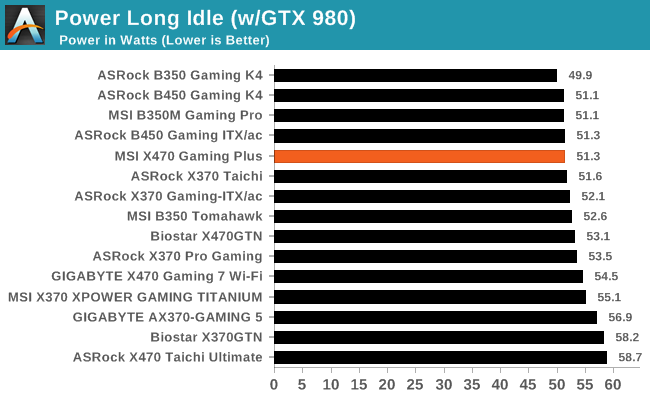
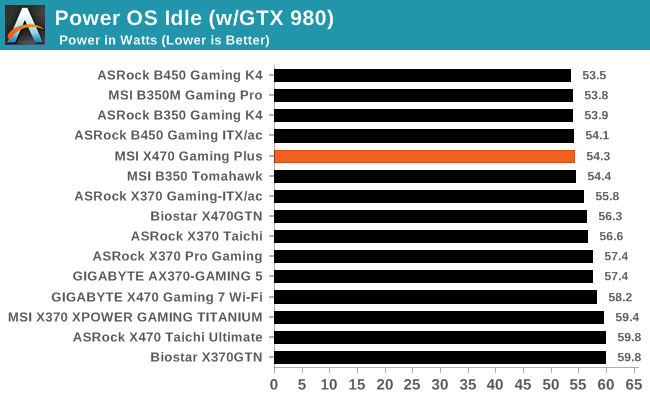
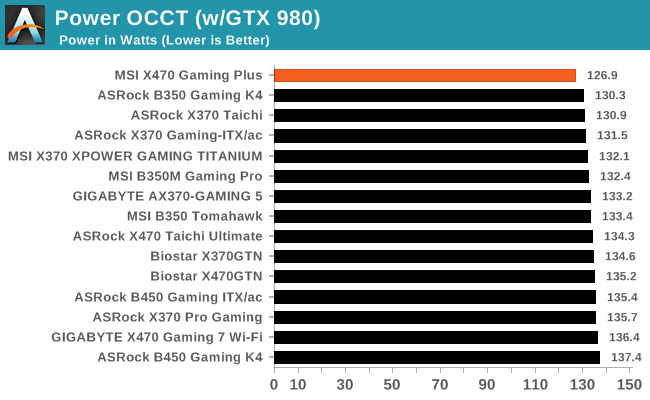
The power consumption in both in a long idle and idle states are pretty good considering for an ATX option and it's clear that the power reduced nature of the second generation of AM4 boards chipsets (B450/X470) seems to have done the trick, at least for MSI on the X470 Gaming Plus. Power at load under OCCT managed to achieve one of the lowest power draws from an AM4 motherboard to date.
Non-UEFI POST Time
Different motherboards have different POST sequences before an operating system is initialized. A lot of this is dependent on the board itself, and POST boot time is determined by the controllers on board (and the sequence of how those extras are organized). As part of our testing, we look at the POST Boot Time using a stopwatch. This is the time from pressing the ON button on the computer to when Windows starts loading. (We discount Windows loading as it is highly variable given Windows specific features.)
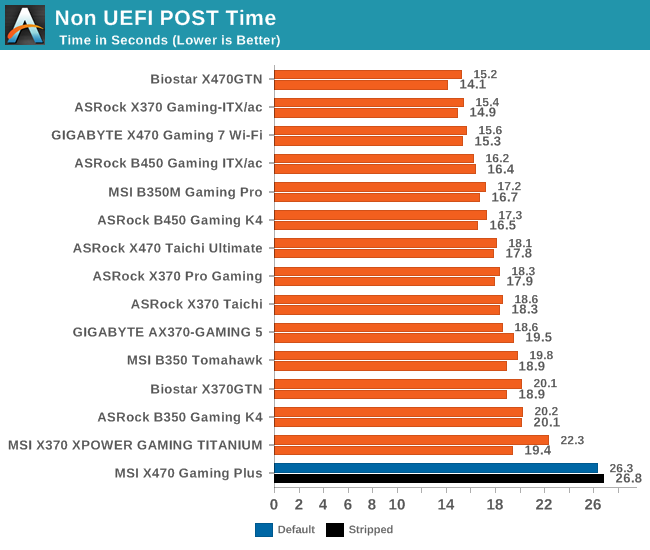
While normally average in terms, MSI's AM4 boards usually achieve some level of consistency within the boards previously tested, so it seems strange that the MSI X470 Gaming Plus completely falls behind the rest of the pack. Even with a re-install the times remained quite long with around 26 seconds under both default and stripped. While this could have been down to an anomaly, a fresh Windows 10 install was installed, the SATA port was changed but still the time taken to boot failed to improve.
Rightmark Audio Analyzer 6.2.5
Rightmark:AA indicates how well the sound system is built and isolated from electrical interference (either internally or externally). For this test we connect the Line Out to the Line In using a short six inch 3.5mm to 3.5mm high-quality jack, turn the OS speaker volume to 100%, and run the Rightmark default test suite at 192 kHz, 24-bit. The OS is tuned to 192 kHz/24-bit input and output, and the Line-In volume is adjusted until we have the best RMAA value in the mini-pretest. We look specifically at the Dynamic Range of the audio codec used on the rear panel of the board.
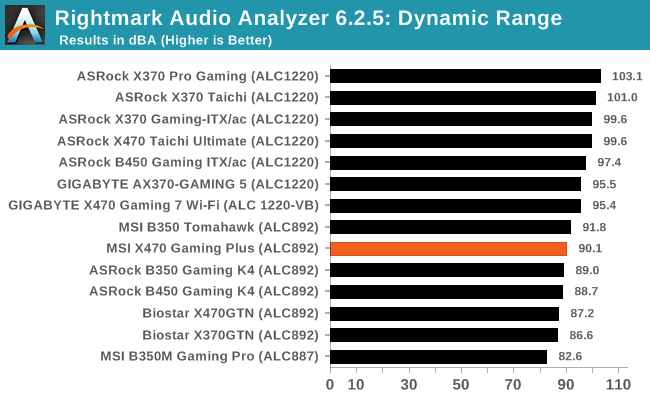
Our Rightmark Audio Analyzer dynamic range testing remains consistent with the Realtek ALC892 clad X470 Gaming Plus sits directly below MSI's own B350 Tomahawk in terms of audio performance.
DPC Latency
Deferred Procedure Call latency is a way in which Windows handles interrupt servicing. In order to wait for a processor to acknowledge the request, the system will queue all interrupt requests by priority. Critical interrupts will be handled as soon as possible, whereas lesser priority requests such as audio will be further down the line. If the audio device requires data, it will have to wait until the request is processed before the buffer is filled.
If the device drivers of higher priority components in a system are poorly implemented, this can cause delays in request scheduling and process time. This can lead to an empty audio buffer and characteristic audible pauses, pops and clicks. The DPC latency checker measures how much time is taken processing DPCs from driver invocation. The lower the value will result in better audio transfer at smaller buffer sizes. Results are measured in microseconds.
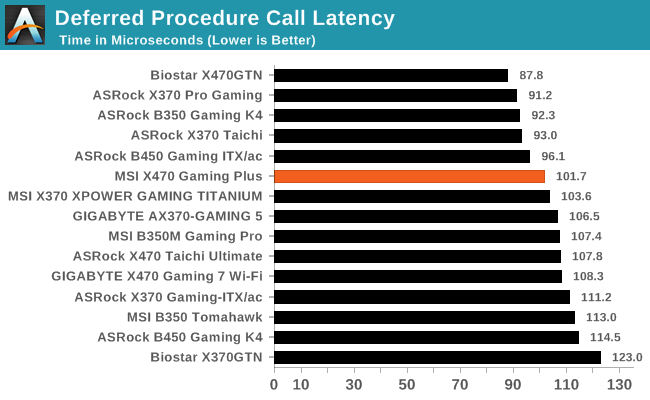
None of the manufacturers AM4 offerings so far have been optimized for DPC latency but despite this, the MSI X470 Gaming Plus puts in a good showing compared to most of the other options previously tested.










27 Comments
View All Comments
gavbon - Thursday, October 4, 2018 - link
Depending on what happens with AMD's roadmap into 2019, we might get a sample in for review as we've seen quite a few different mini-ITX boards from different vendors on AM4; would make sense to test the B450 Gaming ITX/ac too! All depends on time reallyDragonstongue - Thursday, October 4, 2018 - link
B450 pro carbon AC all the way, very close to same price and MUCH better overall build quality..one would figure a "top end" chipset would not be trying to cut things down just to make potential sales when there are many options that are readily available, why add tons more choices and instead settle on making those choices as best as they possibly can be.they could have for example completely made no RGB added a few USB ports (like USB2 or "standard" USB3.1a support) or even used that price difference to use the much better 1220a audio (like found on the B450 gaming pro carbon AC) or even put more higher quality VRM or beefier heatsink design...RGB should not be a "direct focus" when they are trying to cut corners to hit a lower MSRP level, if anything RGB should be the "last" focus in that regard.
VRM, good amount of USB, real good heatsink design, great audio and so forth IMO are vastly more beneficial then disco light show RGB...am sure some folks like it being "on board" but many of those same people add their own lighting ANYWAYS...maybe a dedicated couple of sockets for powering user added lighting might be "ok" but disco light show soaking up a chunk of BOM in most cases is stupid.
new craze of bleed eyeballs with lighting needs to die horrible death, creating more waste and problems with software/hardware and cutting back quality to be able to do it, benefits few people and harms the rest for nothing.
gavbon - Thursday, October 4, 2018 - link
B450 Pro Carbon AC looks good on paper, but I'm a big fan of the B450 Tomahawk (review coming soon) - Not as flashy, bit cheaper and probably more than any gamer is going to use with a single graphics card installed!drexnx - Thursday, October 4, 2018 - link
are the RGBLEDs in this (and the B450 tomahawk as well) true 16.7 million colors capable, or gimped with only 7 color choices like the B350 tomahawk?Arbie - Thursday, October 4, 2018 - link
I am continually amazed at what motherboard manufacturers can produce at these price levels. The materials, technology, and effort that goes into putting something like this on a retail shelf is mind-boggling. If it cost $1K I could hardly argue, considering what it takes. $120 seems like a giveaway - a planter stand for my backyard costs the same. This must be one of the toughest markets in the world.Oxford Guy - Friday, October 5, 2018 - link
Especially considering how much they pay marketeers to come up with new deceptive advertising.WatcherCK - Thursday, October 4, 2018 - link
Gavin, thanks for highlighting the fact that board makers can be very flexible with their descriptions of board features (is it to the point of being misleading)? Just wanted to add that Buildzoid/Actual Hardcore Overclocking has been digging into the state of B450/X470 boards recently with a deep dive into the VRM setups... My take away so far is that the MSI boards appear to be fairly well setup for their price compared to others, but there is a board out there for every usage scenario/price point you want more you pay more as with all things in life :)Oxford Guy - Friday, October 5, 2018 - link
"board makers can be very flexible with their descriptions of board features"... a roundabout way of saying they lie.
The_Assimilator - Thursday, October 4, 2018 - link
Back in the LGA775 days, MSI sold a high-end motherboard called the P6N Diamond that was advertised to have support for quad-core CPUs. Except they skimped on the power delivery circuitry, so "support" meant "if you use a quad-core your system will randomly reboot itself".Good to see things haven't changed.
Galcobar - Thursday, October 4, 2018 - link
The overview page states the HDMI connector is 1.4, while the every other mention states it is 2.0.